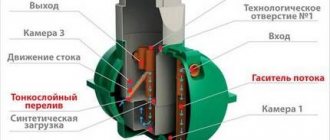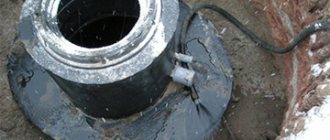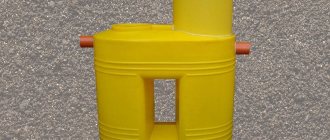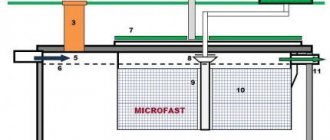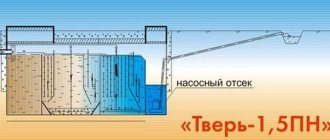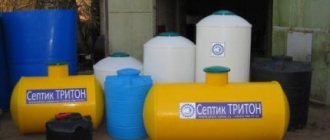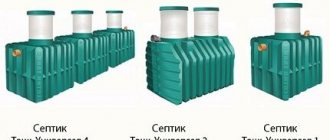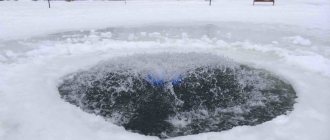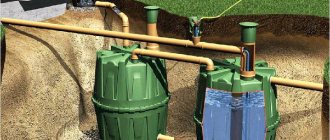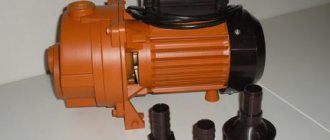Against the backdrop of numerous options for arranging local sewerage, septic tanks DKS (now KLEN) stand out. The units are affordable and easy to maintain.
To decide whether this solution is suitable for a particular country house or dacha, you will need to get a little closer to the model range of DKS septic tanks, find out the structure and operating principle of the treatment equipment. Our article is devoted to these questions.
In addition, we will talk about the features of installation, operation and maintenance of a septic tank, and outline its strengths and weaknesses. The information provided will help you navigate the variety of models and choose the best option for arranging a local sewer system.
Design and principle of operation
Septic tanks Klen are a container made of polypropylene with technological holes in the upper part of the body and two pipes for installing inlet and outlet pipelines. The system is equipped with necks for comfortable maintenance of the unit buried in the ground.
Septic tank Klen-5N on an area with a high groundwater level
The inside of the container is divided into three or four compartments (depending on the model):
- Primary settling tank.
- Secondary settling tank.
- Biofilter.
- Storage (available only on models with the prefix “H”, which are volatile).
The wastewater treatment process consists of several stages:
- Domestic sewage flows by gravity into the primary settling tank. It separates waste into liquid and solid components. The liquid flows through the overflow, located at 1/3 of the height of the tank, into the next compartment (secondary settling tank), and the solid fractions settle to the bottom. In addition to settling, the process of processing feces into sludge by methanogenic microorganisms - anaerobic bacteria - occurs in the cavity of the settling tank. Bacteria enter the septic tank along with human waste products. These microorganisms do not require air to function. They trigger the fermentation process, as a result of which the light fractions are freed from gas bubbles and settle to the bottom along with the heavy components.
- In the secondary settling tank, the process of separating wastewater into liquid and solid fractions continues. The anaerobic process, that is, the work of bacteria, also continues.
- A biofilter is installed in the upper part of the secondary settling tank. Its cavity is filled with a brush load, and the liquid enters it through a supply pipe equipped with a drip sprinkler. The water that has passed through two settling tanks enters the biofilter in small portions and is sprayed throughout the biofilter cavity. Colonies of another type of bacteria – aerobic – live on the surface of the brush load. The life activity of these microorganisms occurs with the participation of air. Therefore, the biofilter has a pipe leading to the surface for aeration. In the biofilter, with the help of aerobic bacteria, the liquid is purified from residual small contaminants.
- Purified water from the biofilter enters the storage tank. A drain pump and a float sensor are installed in the storage tank. The pump starts up automatically when a signal is received from a sensor that detects a rise in the liquid level in the storage tank to a certain level. The pump pumps water into the drainage system, which is a perforated pipe. The purified liquid penetrates the small holes of the pipe and is distributed in the soil.
Device and connection diagram
Note! The process described in paragraph 4 applies only to Klen-3N, 5N and 7N septic tanks. That is, installations with forced drainage. For models that do not have the prefix “H” in their markings, there is no storage tank, pump or float sensor, and purified water flows by gravity through the outlet pipe from the second sump.
The manufacturer claims that the need to pump out the septic tank occurs only once every two years. Sludge is removed from the container using a drainage pump or a sewage disposal machine (the so-called “sludge sucker”).
Environmental Safety
The septic tank for MAPLE clay is completely safe for human health and does not have a negative impact on nature. All thanks to the unique cleaning technology introduced into the equipment by engineers. Entering the intended container, wastewater is subjected to sequential purification, carried out in several stages. Biological filtration deserves special attention, thanks to which the water leaving the equipment does not pose a danger to the environment. Other advantages are expressed by the completely silent operation of the septic tank and the use of safe materials.
The lineup
The model range of Maple septic tanks is represented by units with a volume of 1, 1.5 and 2.5 cubic meters. Technical characteristics of wastewater treatment devices can be found in the table.
| Septic tank modification | Volume, cubic meters | Productivity, l/day | Length, m | Height, m | Width, m | Weight, kg |
| Klen-3N | 1 | 200 | 1.2 | 0.88 | 0.91 | |
| Klen-5 | 1.5 | 450 | 1.5 | 1.1 | 1.1 | 52 |
| Klen-5N | 1.5 | 450 | 1.95 | 1.1 | 1.1 | 57 |
| Klen-7 | 2.5 | 750 | 1.5 | 1.5 | 1.3 | 72 |
| Klen-7N | 2.5 | 750 | 1.95 | 1.5 | 1.3 | 77 |
Septic tank models with the “N” prefix are equipped with an additional storage chamber, a pump and a float level sensor. They can be installed in areas with any groundwater level.
Models without the “H” prefix can only be used at low groundwater levels, since the container of these units is not sealed, melt or groundwater can easily penetrate into the outlet pipe and fill the unit with liquid. This is the main disadvantage of such models.
What the Klen-5N septic tank looks like, and how it differs externally from Klen-5 can be clearly seen in the figure.
The difference between the model with a storage device (5N, on the right) and the model without a storage device (Klen-5, on the left)
Note! The manufacturer does not include neck extensions in the installation kit. They are purchased separately and can have different heights.
Video
After installing and leveling the septic tank, insert the neck extensions and completely fill all sections with water.
Attention! According to the instructions, it is not necessary to attach the septic tank to a concrete slab in order to avoid squeezing it onto the surface of the ground, because... this will not happen in any case - the septic tank is constantly filled with water and has a special shape.
Now we lay foam plastic along the edges of the septic tank and on top - for this you will need a sheet of 1x2 meters 5 cm thick. We fill the septic tank halfway on all sides with sand, which we then spill with water to compact the backfill.
Selection rules
The first indicator on the basis of which the installation power is selected is the number of permanent residents in the house.
The manufacturer claims that for a comfortable stay at a dacha or in a country house, one person needs 90-100 liters of water per day. The table shows the approximate number of people for models of various capacities, recommended.
| Model | Daily productivity, l | Number of people | Type of accommodation |
| Klen-3 | 200 | up to 4 | Day off |
| Klen-5 | 450 | 3-5 | permanent |
| Klen-7 | 750 | 4-7 | permanent |
The next indicator for choosing a modification is the groundwater level. If the groundwater on the site is closer than 2 meters to the soil surface, then the choice should definitely be made in favor of models with forced drainage.
The composition of the soil on the site should also be taken into account. Septic tanks Klen-5 and Klen-7 are suitable only for sand or peat. On clay soils, as well as with high groundwater level, Klen septic tanks marked “N” are installed.
Note! If the house has several sinks, a bathtub, a dishwasher and other plumbing fixtures, then for reliable operation of the septic tank, it is necessary to select the installation power with a margin of about 20%.
Positive traits
Series 5 and 5N are not too demanding on maintenance - it is enough to remove sediment once every 2 years using a fecal pump or a sewer truck. Among other advantages it is worth highlighting:
- Operational durability
- Full autonomy (Klen 5)
- Simplicity of design
- Minimal Maintenance
- Absolute tightness
The unique technology, along with the simple design of the septic tank, allows the equipment to be used for half a century. It is recommended to trust the installation of a septic tank exclusively to specialists, however, if necessary or desired, you can handle the installation of an autonomous sewer system yourself. Thanks to the sealed design, the environmental impact is zero.
The materials used in the production of septic tanks provide the final product with resistance to temperature changes. There is also no need to connect to the central sewer system. The complete energy independence of the wastewater disposal system attracts the attention of summer residents and owners of country houses. The solution under consideration is ideal against the backdrop of septic tanks made of concrete rings, expensive deep biological treatment systems, storage tanks and cesspools.
Installation and installation
The installation of a septic tank on a summer cottage should begin with the selection of a location. Ideally, the unit should be located below the level of the house on the side of an area with a natural slope of the ground level. This will ensure good drainage.
It is recommended to prepare the pit immediately before installing the container in order to reduce the likelihood of walls falling off and flooding with groundwater. The bottom of the pit is leveled and covered with a layer of sand 5-10 cm thick. The table shows the dimensions of the pits for different modifications of Maple septic tanks for deepening the tank by 1 and 0.5 m, recommended by the manufacturer.
Recommended dimensions of pits for installation
The septic tank is lowered into the prepared pit and set according to the level.
Note! It is allowed to install the unit at a slight slope towards the storage tank. But the slope should not be more than 1 cm per linear meter.
Neck extensions are placed on a firmly installed unit. After this, the entire container is filled to the top with water.
The container is insulated on all sides with foam sheets. The gaps between the foam plastic and the walls of the pit are filled with sand and spilled with water to compact the backfill.
Next, trenches are dug for pipe installation. The inlet and outlet pipelines are installed. In order to prevent the formation of blockages, the sewerage to the septic tank should be laid with a slope of 1.5-3 cm per linear meter.
Attention! When installing septic tanks Klen-5N and 7N, when laying a pipeline from the storage tank in a trench, along with the pipe, an electric wire with a cross-section of 1.5x3 mm should be laid to connect the drainage pump. This cable should be laid in a corrugated cable. An electrical plug is mounted at the end entering the house.
In order to remove gaseous products from the processing of fecal matter, a ventilation system must be installed on the unit. The manufacturer suggests implementing it according to one of the recommended schemes.
Possible ventilation organization schemes
For volatile septic tanks (additional marking “H”), a drainage pump is installed and connected in the storage tank cavity. How this is done in practice is clearly shown in the video.
Myth No. 3. Bacteria die due to powder or SMS
A septic tank is a sewage system designed for such loads. For example, models are resistant to substances:
- shower gel, soap, bath foam;
- SMS, washing powders, capsules, rinse aids and fresheners;
- dishwashing detergents;
- vinegar, soda or acids.
But such compositions should be in moderation. Do not pour large quantities of aggressive substances into the septic tank: acids, alkalis, paints, solvents. The reason is that due to a lack of organic compounds, microorganisms may die. But with normal use (toilet, washing machine, shower) everything will be fine. Country sewerage - a septic tank will last more than 50 years.
ATTENTION! The maximum that may be required is the addition of new bacteria.
Ventilation device
Septic tank ventilation is very important to maximize the potential of the septic tank and get rid of stagnant processes and unpleasant odors.
To install ventilation you will need a gray sewer pipe Ø 110 mm and a length of 2 meters.
The photo shows examples of ventilation installation.
(click on the photo you are interested in)
Description of autonomous sewage system for a summer residence
To be able to fully live in a private house, it is necessary to build a sewer system and choose a method for disposing of the residents’ waste (sewage treatment plants). Before installing the desired structure, you need to familiarize yourself with the range of autonomous sewers and weigh all the positive and negative aspects of each of them.
It is better to entrust the installation of an industrial septic tank to professionals
Previously, this sewerage option was the only one; the owners of the house had no other option. This design is the simplest. A sealed container is buried on the site, which is filled with wastewater through the collector. The pipeline is laid deep enough so that the pipes do not freeze; they are insulated.
Drives can be made from different materials:
- Made from brick - can only be used from ceramics; it is most resistant to liquids. The structure should have the shape of a cylinder, so it is the most durable.
- Made from reinforced concrete rings - such installation requires the use of additional technical means. The construction of this material is very durable, the risk of walls collapsing is minimal.
- The plastic container is resistant to moisture, acids and alkali. Reliable and durable. It is light in weight, making installation easy.
A reinforced concrete monolithic container is also suitable; it is cast using a special mixture of sand and cement directly at the site of the pit using waterproofing. Before installing wastewater storage tanks, you need to familiarize yourself with the requirements of sanitary rules and regulations.
Reviews of septic tanks Maple
Valery, 33 years old, Saratov
I have been using a 5N septic tank for 3 years. I haven’t had a chance to clean it yet, because no one permanently lives in the house outside the city. During this time, no problems arose: the device is functional, productive, and copes with its task.
Gennady, 43 years old, Voronezh
Maple 7 has been standing at the dacha for two years now. We use the sewerage regularly, because there is a residential building on the site. The dacha is located not far from the city, I often stay there, it’s convenient to get to work by car. The septic tank is inexpensive, but this does not mean that it is of poor quality. Despite frequent use, the structure works reliably.
Myth No. 5. If the area has clay and loam, only a storage tank will help
This was the case for a long time. But today you can find a septic tank for sewerage on any site:
- sand;
- loam;
- peat;
- clay;
- Earth;
- quicksand.
offers models designed both for installation in “filtering” soils and for installation in “non-filtering” soils. The advantage of the systems is that they are created taking into account the Russian climate: temperature changes, freezing depth, frequency of flooding due to high groundwater levels.
Why should you pay attention to equipment?
Septic tank (sewerage) for a summer residence:
- comes in 6 modifications (from “three” to “seven”);
- does not require weekly maintenance;
- lasts up to 50 years;
- made from polypropylene sheets 5-8 mm thick;
- saves 20-70% compared to similar systems for organizing a sewage system;
- installed in 1 day on a turnkey basis;
- does not require preservation for the cold season;
- suitable for permanent or seasonal use;
- installed both in areas with high groundwater levels and in areas with low groundwater level.
Choose!
Disadvantages of septic tanks Maple
Such devices have significant disadvantages. If you are considering a Maple septic tank, the disadvantages of this design are as follows:
- small wall thickness: from 5 to 8 mm, which is almost 2 times less if compared with analogues in this parameter, and the presence of stiffeners does not reduce the risk of deformation of the body;
- the need to connect a drainage pump to lift treated wastewater;
- It is not recommended to install such a structure in an area where the soil is quite mobile; this may cause deformation of the body.
